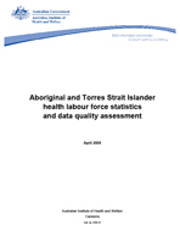Summary
Indigenous health labour force statistics
The report found that there were increases in the size of the Indigenous health labour force in most sectors, although data quality issues mean that care should be taken in interpreting the results.
- The Census of Population and Housing (Census) recorded 106 Indigenous medical practitioners in 2006 (82 general and 24 specialist). There was a higher number (147) of Indigenous medical practitioners found in the 2006 Medical Labour Force Survey (MLFS). However, some of this difference may be explained by the presence of a large number of Indigenous status not stated responses in the Census—a proportion of which is likely to be Indigenous.
- Between the 1996 Census and the 2006 Census, the number of Indigenous general practitioners doubled (from 41 to 82).
- The 2006 Census recorded 1,135 Indigenous registered nurses. The 2005 Nursing and Midwifery Labour Force Survey (NMFLS) recorded a much lower figure of 644, possibly related to a low response rate and other data quality issues.
- The 2006 Census found that there were 222 Indigenous enrolled nurses, while the 2005 NMLFS recorded a higher number at 419.
- The number of Indigenous enrolled nurses declined 61% between the 1996 and 2006 Censuses, while the number of registered nurses increased by 71%. This can be partially explained by nurses upgrading their qualifications.
- The number of Aboriginal Health Workers increased from 669 in 1996 to 961 in 2006.
- The number of Indigenous students enrolled in a vocational education and training (VET) health course decreased between 2002 and 2006, from 3,565 to 3,255.
- However, the number of Indigenous health students in higher education increased between 2001 and 2006, from 1,104 to 1,426.
- The number of Indigenous people with a post-school qualification in health more than doubled between 1996 and 2006 (from 2,707 to 6,326).
Data quality issues
A range of data quality issues were identified, including:
- the under-identification of Indigenous people which was common to most of the data sets examined, seen in the high proportion of missing ('not stated') responses to the Indigenous status question
- the Census undercount of the Indigenous population, which was estimated to be 12% in 2006, twice as high as in the 2001 Census (6%). This may have affected the counts of Indigenous health professionals
- low response rates in both the MLFS and the NMLFS data collections, particularly in the Northern Territory.



